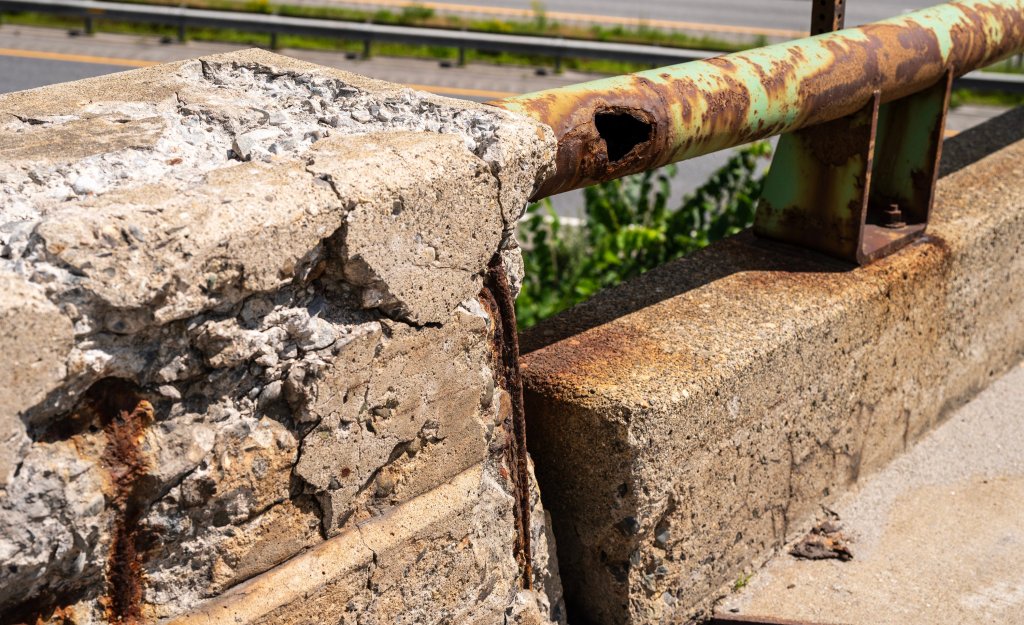AUGUSTA — Work is expected to begin this fall on a multi-year project to replace a heavily traveled bridge that carries U.S. Route 202 over Interstate 95 and increase the area’s accessibility for pedestrians and cyclists.

Devan Eaton, a senior project manager for the state Department of Transportation, said the bridge built in 1955 has failing paint, an eroding slope, rusting steel beams, worn-out bearings, cracked and breaking concrete and does not provide enough clearance for vehicles passing below.
While transportation officials now generally expect bridges and other structures to last between 75 to 100 years, this particular bridge — near the Turnpike Mall — has had a rough 68 years. Replacing it could require up to four years of construction and about $30 million.
“There’s cracked and spalled (broken up) concrete all over the place — it’s been a salt spray zone its entire life,” Eaton told Augusta city councilors during a recent presentation. “With the amount of traffic on the structure, that’s not surprising.”
The work expected to take place this fall includes the start of construction on a new temporary bridge to be built just north of the existing bridge. Officials have not yet announced when, specifically, that work will begin. But major traffic disruptions are not expected until the 2025 construction season, when traffic will switch to the temporary structure. The project is slated to be completed by June 2026.
The temporary bridge will have only three lanes total — two westbound toward Winthrop and one eastbound into Augusta. There are currently six lanes on the bridge, including turning lanes.
“The goal is to only impact actual Western Avenue traffic for one season, with that temporary bridge,” Eaton said. “It’s a crucial part of the city, with the in and out of the commuter traffic, so we understand the complications of it and the impacts it’s going to have. Some aspects won’t be pretty — there’s kind of no way around that. We’re doing everything we can to keep things moving.”

Rust and cracked concrete are seen Wednesday on the Western Avenue bridge over Interstate 95 in Augusta. Joe Phelan/Kennebec Journal
Thousands of vehicles travel that area daily. U.S. Route 202, which is also Western Avenue, sees 16,960 vehicles heading eastbound and 10,970 traveling westbound each day, according to state data. Under the bridge, on Interstate 95, data shows 20,190 vehicles travel northbound and 14,810 southbound daily. Whitten Road, near Texas Roadhouse and Hannaford, sees 4,961 vehicles daily.
Eaton said the project will be challenging due to the site’s tight confines and heavy traffic.
Some motorists will be required to follow new routes, particularly those looking to take a left turn off Western Avenue onto Whitten Road, which won’t be allowed at the current intersection of those two roads.
Instead, motorists coming westbound on Western Avenue and looking to turn left onto Whitten Road to, for example, go to Hannaford, will use the southbound onramp for Interstate 95. Before that ramp takes traffic onto Interstate 95, a temporary access road, much of which already exists due to a previous project at the site, will allow motorists to turn onto Whitten Road, just beyond the Maine Evergreen hotel.
The project plans include the addition of new sidewalks and pedestrian crossings, including a sidewalk on the south side where there currently is none. Work will take place on nearly 3,500 feet of sidewalk, between Edison Drive and Senator Way, including 1,870 feet of entirely new sidewalk.
Tyler Pease, city engineer, said the state added sidewalks to the project after presenting initial plans for the site. At first, MDOT indicated the city may have had to pay for part of the sidewalks, but the state has since agreed to take those on.
Eaton said the project had additional funding to add better pedestrian access, noting that the area is walked so frequently there are beaten paths on the side of the road. A bike lane will also be added to the eastbound shoulder area, up to Senator Way.
“I’m just thrilled with the sidewalks,” said Ward 1 City Councilor Linda Conti. “And I hope this is a trend with the DOT and they’re going to include sidewalks with a lot more of their projects, because that has been an issue for us before.”
The bridge will be raised to increase its vertical clearance for traffic passing below on Interstate 95, from the current 14 foot, 4 inches, to 16 feet, the federal minimum for highways.
Send questions/comments to the editors.






